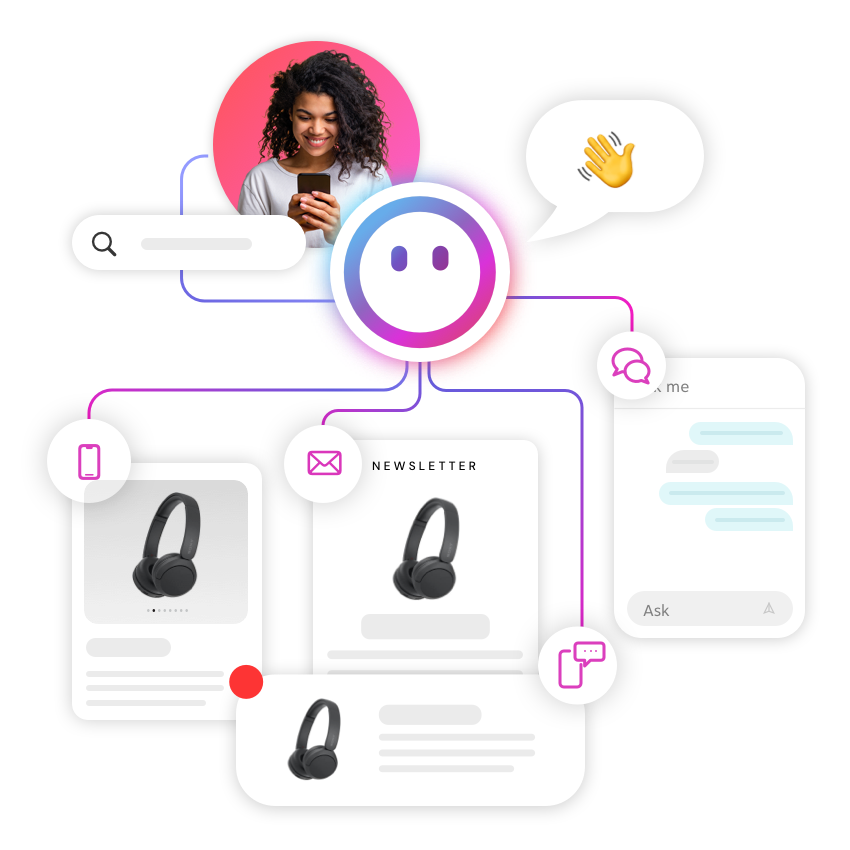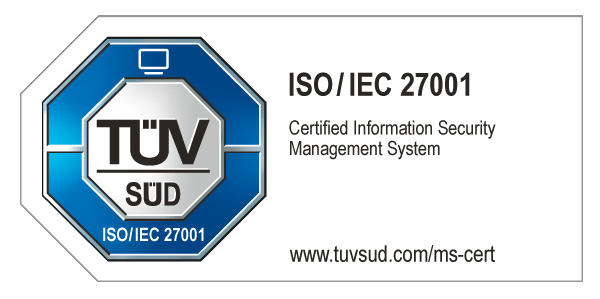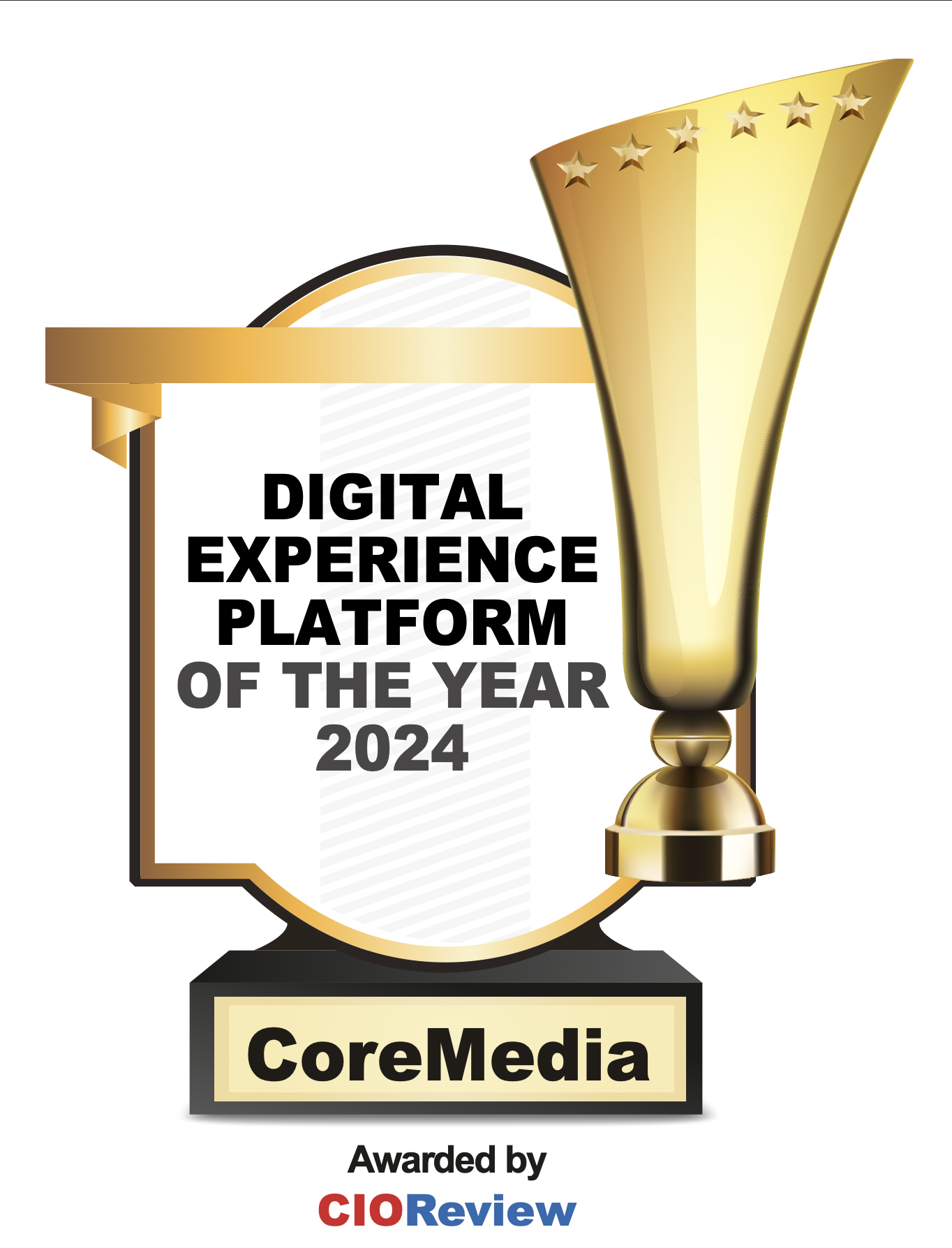Introducing CoreMedia Content Cloud – Part I
Here at CoreMedia, we’re proud of our product, our employees and - most of all - our clients. We believe that we have a truly unique set of technologies that allow our clients to differentiate and become global leaders in their respective markets.
We believe that CoreMedia Content Cloud provides the most flexible, scalable and powerful platform for brands to build truly innovative digital experience solutions. But in the noisy world of digital marketing and PR where every vendor makes similar claims and new buzzwords appear on a regular basis, it can be hard to explain just what makes our platform so special.
This three-part blog series is intended to address that question from both a business and technical perspective.
CoreMedia Content Cloud is based on everything we’ve learned working for some of the world’s most iconic brands. But in this first installment of the series, let’s look at how we got here.
Content is an Asset
CoreMedia has been in the content management business since 1996 and we’ve been blessed to learn from the best. Our first two clients were Deutsche Presse-Agentur (DPA), the largest press agency in Germany, and Axel Springer, the largest publisher in Europe. They taught us a fundamental idea - that content is an asset - and a valuable one. It needs to be managed well and in a semantically rich way to create the most value.
Carrier-Grade for All
Next, we gained insights collaborating with the largest telecommunication companies in the world. Working for Vodafone, T-Mobile, Telefonica, Softbank and Bell Canada taught us what it means to build and run “carrier grade” systems – when going down is not an option. One of our most exciting projects was providing the content platform for the Vancouver 2010 Winter Olympics.
But we didn’t stop there. We targeted the next group of innovators: luxury brands. And that important decision led to where we are today:
Graohic Platform Evolution
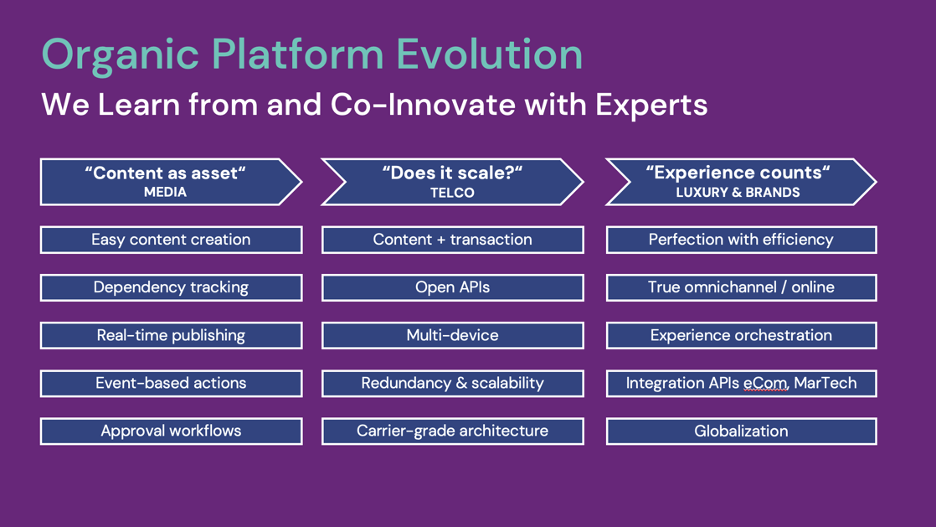
CoreMedia Content Cloud: Customer-First Evolution
It’s About the Experience
Luxury brands have mastered a crucial skill that’s increasingly in demand: creating iconic experiences. Because in a world of abundance, you have to stand out.
Luxury goods represent the ultimate in discretionary spending. No one needs a new high-end handbag or an expensive dress, but people want them. There is demand - a lot of it - and it’s only growing, as is the competitive landscape. This means that buying luxury goods has to be a delightful experience from beginning to end, or it won’t happen at all.
The lesson is: It’s all about the experience. And I’m convinced this is true not just for luxury brands, but for every organization in every industry.
In a globally networked world, chock-full of more options than ever, no customer really has to buy from you. An alternative is just a click or a swipe away. If your competition can provide a better experience, their story will spread and they will win.
Content is King
Despite the crush of options out there, one very surprising thing I’ve observed is this: content is still vastly under-appreciated as a success factor.
While every amazing experience has great content at its core, most organizations don’t come close to harnessing the power of their content. Luxury brands and media companies are pushing the envelope, but even they struggle to master content across today’s explosion of devices and touchpoints.
Enterprise Software Hasn’t Mastered Content
One factor that limits organizations is the available technology, as most enterprise software platforms fall short in content management. Marketing and commerce platforms, CRMs and ERPs are built to handle efficient processes that can be standardized to scale. But content doesn’t fit that mold.
While the most iconic brands do need efficient back-end processes, they will never accept standardized experiences because they need to be able to use content in ever-evolving ways. They need to create with their content like an artist creates with a paintbrush, and that is impossible with most enterprise software.
Content Lives in Many Places
There’s also this: The idea that you can move all your data and content into one single system is a pipe dream. It will never happen. The reality is that enterprises need robust distributed systems: product data in a PIM or eCommerce system, customer data in a CRM or Marketing Cloud, videos on YouTube or another streaming service, and so on.
But these specialized systems are being connected through increasingly powerful platforms that share access to real-time data. The result is an integrated view of a distributed system.
What Iconic Experiences Require
To create iconic customer experiences, companies need to integrate three essential ingredients: content, commerce and context.
- Content: You need it to tell a story because companies without a compelling story will fail. Products without a compelling visual story will turn into commodities. Even B2B products need more and better content to be found, to educate and to convince.
- Commerce: You need to be able to handle transactions, process payments and deliver orders efficiently and at scale. You also need access to real-time inventory information in all your locations. This has been the sweet spot of platforms like Salesforce Commerce Cloud, SAP Commerce Cloud and HCL Commerce. And there are new players like Elastic Path and commercetools who also excel at this.
- Context: You need contextual data to personalize experiences for every customer: who they are, where they are, what device they’re using, which language they prefer, their browsing history, buying intent and more. An ever-growing number of systems provide various aspects of this.
Business Logic Integrates Data Sources
But to build an effective personalized experience, all three ingredients must be blended seamlessly through business logic.
Once you find out who the customer is and where they are, your platform has to determine the right set of products based on their preferences, location and available inventory in your commerce platform. Language preferences also require your system to select the relevant content in the matching language. And based on device type, the system has to select the right crops and image resolution.
All this must happen in milliseconds for the whole experience to be optimal - that’s a tall order.
Omni-Channel is the New Norm
The separation between digital and non-digital is also gone. Customers don’t care about different “channels”, they care about seamless experiences tailored to their own preferences.
Maintaining this consistency is a challenge and if there’s a mismatch – between products, prices, imagery or messaging – customers will run. This is what the world’s most successful brands – like Apple, Nike or Adidas - have mastered. They are iconic because their experiences are completely unified.
The Global Village is Here
Marshall McLuhan’s global village is today’s reality. It used to be that new trends, new insights or new products arrived in different places around the world at different times. No longer. New developments happen instantly, and customers expect global brands to be agile. When a new iPhone comes out, it needs to be simultaneously available in Hong Kong and San Francisco, along with product information in Cantonese.
And languages aren't restricted to geographical areas anymore; global travelers take their language preferences with them. Can your brand display product information in English when your English-speaking customer is in Japan?
Experiences Need Orchestration
What’s clear is that an ever-increasing complexity of systems, touchpoints, devices, apps and features are challenging the ability of marketing executives to deliver results because marketing teams are often highly dependent on IT departments. But they shouldn’t be - marketers today need to be more agile and empowered, not less.
Global Campaign Orchestration
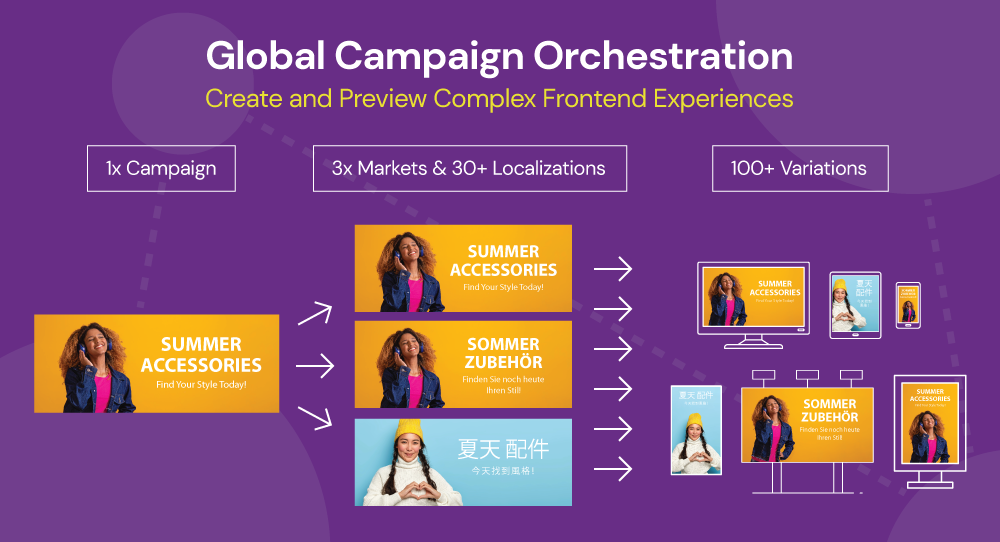
CoreMedia Content Cloud: Global Campaign Orchestration
Marketers need to be able to orchestrate whole experiences on a global scale across all touchpoints. They need to be able to edit content, design banners, create landing pages, translate text, roll out global campaigns, preview experiences and measure results. They need to be able to do all this in real-time. And they need powerful tools to help them.
An Open Composable DXP
Which brings us back to Content Cloud.
Every new client and every new industry that we worked with brought us a deeper understanding of the strategic challenges around content and experiences.
Instead of replacing countless other systems with an inflexible monolith, we’ve fully embraced best-of-breed architectures, open APIs, integration hubs and out-of-the-box integrations.
CoreMedia Content Cloud is a flexible, composable Digital Experience Platform (DXP) built on an agile CMS and advanced DAM that enables brands to orchestrate personalized experiences and deliver them to any channel – reliably, efficiently, and at enterprise scale. Marketers, merchandisers, and developers can work collaboratively and efficiently on omni-channel experiences that drive engagement, increase loyalty, improve brand visibility, and boost revenue.
The Future of Luxury Fashion
So, are you curious what the future will look like with CoreMedia Content Cloud?
Imagine this: An executive from Japan is heading to Europe for dinner with the French president. On arrival, she learns her luggage is lost. She needs a new outfit now.
She immediately pulls out her mobile and starts searching. The her favorite brand’s app suggests a stunning black dress and indicates it’s available – today, in her size, at the flagship store in Paris. With just a click, she makes a reservation for a fitting in one hour.
At the store on Avenue Montaigne, things start happening. The store manager receives a notification about the imminent arrival of a VIP along with details of the appointment. A selection of dresses and accessories is prepared, and a digital scene is set. The store features digital displays built right into the surfaces showing high-definition images of the current collection, and these are customized for the anticipated customer with a few clicks from an iPad.
As the guest enters the store, the setup is activated, producing a fully immersive, custom-tailored experience. Product details are displayed in Japanese. Currency options are shown in Yen and Euros. Video footage of the black dress being worn at this season’s runway shows appears on the screens. When the guest looks around, the whole store feels like it was designed just for her.
The guest tries on a variety of black dresses, then wonders how a white dress in a similar style might look. The store manager touches her tablet and instantly all screens display videos and slide shows of the best matching white dresses. The guest is curious about one dress in particular. With a tap, the store manager selects the item, and all screens display more inspirational content about it.
Or, instead of a tablet, the store manager opts to use a voice assistant: “Show us black dresses from the current collection” or “Show us the details for the first dress on display” or even “Inspire us.” After every request, all of the store’s screens instantly update and display compelling content optimized for each screen.
After settling on the perfect black dress, the guest is also intrigued by a coat she spotted in one of the videos. It’s not currently available in the store, so she uses an Augmented Reality mirror to see how it would look on her. The image is ultra-realistic, and she can tell the coat will flatter her figure. She places an order to have it waiting for her back in Japan.
When she finally leaves the store – perfect black dress in tow plus accessories – she is happy and serene, ready for her important state dinner with dignitaries (and anticipating her cool new coat).
Touchscreen

“The future is already here — it's just not very evenly distributed.”
- William Gibson
This scenario may seem far-fetched, but it’s not. Physical stores will soon start to mirror digital stores in a variety of ways. The technology for this exists today, it’s just not “evenly distributed.” The challenge, of course, is mastering the technical complexity to orchestrate these kinds of experiences. The new luxury – and the new eCommerce – will be about brands becoming trustworthy, unobtrusive, and empowering.
It’s clear that content will be key more than ever before. Customers will expect consistency between all touchpoints and seamless journeys across them. Brands will need to embrace those touchpoints to reach their most desirable customers and to orchestrate increasingly inspirational content related to their products on the spur of the moment and the touch of a button.
That’s why we created CoreMedia Content Cloud. I can’t wait for you to see it.
See for Yourself
If you’d like to see for yourself, contact us today for a demo.
Or check out the rest of our Introducing CoreMedia Content Cloud blog series to learn more:
Part II: Why Your Brand Needs Best-of-Breed Marketing Technology
Part III: Achieving Measurable Business Results for Your Brand
About CoreMedia
CoreMedia Content Cloud is the number one choice of market leaders like Luxottica (sunglasses) and the Yoox Net-a-Porter Group (luxury eCommerce). CoreMedia is committed to excellence, openness, and innovation. So, if you’re looking to transform your brand into an iconic one through content, let’s talk. I think this is the beginning of a beautiful friendship.
